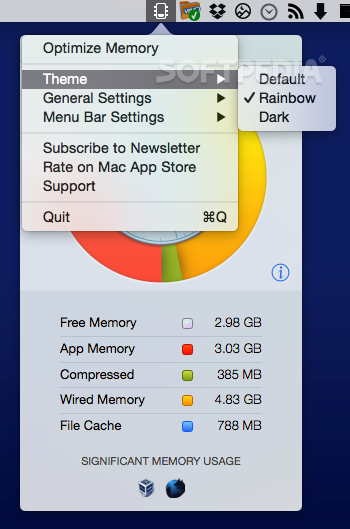

- #Memory monitor 2 osx how to#
- #Memory monitor 2 osx install#
- #Memory monitor 2 osx upgrade#
- #Memory monitor 2 osx software#
- #Memory monitor 2 osx plus#
As most of us have 16GB of ram, this made our machines unusable.
#Memory monitor 2 osx install#
I think I was already on 6.1.4, but I don't have a Mojave machine so I can't test this theory.Įveryone in our development team had to install 6.1.2 because we generally allocate 8GB to the virtual machine, which ended up using 16GB. It's possible this bug might specific to Catalina, as I personally only noticed running out on memory after upgrading from Mojave. We couldn't find a bug report about it, but we did find a few reports on the forums: Reverting back to 6.1.2 fixes the problem.
#Memory monitor 2 osx plus#
Meanwhile, we have a guide to freeing up Mac memory with greater control over how you use apps, plus other tricks that could help if your swap usage starts to look alarming.We recently noticed that memory usage doubled on Catalina (confirmed on 10.15.5). You can go to your About this Mac section on MacOS and select the Memory tab to see if you have any empty slots left. iMacs tend to be a little luckier in this respect - some may have empty slots for adding more memory, although Apple will want you to use its own technicians. Most recent-generation MacBooks have their RAM soldered directly to the motherboard, for example.
#Memory monitor 2 osx upgrade#
While the cure for RAM issues can often be an upgrade to more RAM, that’s not a solution that works for Macs.

But if it suddenly starts spiking to much higher levels for no apparent reason, it could be the sign of a problem, especially if your computer crashes soon after. Your swap memory used total suddenly starts spiking: If your swap memory is consistently a couple of GBs or so, you probably don’t have anything to worry about.
#Memory monitor 2 osx software#
It’s a good idea to check your memory stats when you first start running complex software and make sure your RAM is able to handle what you’re doing.


So, if the swap used section doesn’t necessarily indicate a problem, how can you tell if there are issues with your Mac’s RAM? It’s important to consider several factors here to create a clearer picture of how your memory is doing. You can even have several GBs of swap memory used and not notice a thing because RAM is being allocated to the most important tasks. These days, it’s expected to see some swap used, at minimum, just to indicate that startup disk space has been reserved in case it’s needed. In fact, MacOS received major memory updates in Mavericks and Yosemite that adjusted the way memory is allocated to help make RAM use more efficient. It’s an indicator of potential issues, but some swap memory usage is not uncommon. However, swap used doesn’t always mean something is wrong. It tends to become higher if you have a lot of apps or tabs open at once or are trying to manage other complex processes. Swap memory is more likely to be used when your current memory isn’t enough to efficiently handle all the tasks you are trying to do on MacOS. Traditionally, swap used has a bad reputation since it can indicate RAM problems. The operating system does this by borrowing some space from somewhere else - the startup disk, in this case - and using it to temporarily store some data while the RAM is busy handling other tasks. Swap memory is a type of memory that computers use to offload demands on the current RAM.
#Memory monitor 2 osx how to#
You can finally run Windows 11 natively on an Apple silicon MacĬommon macOS Ventura problems and how to fix them


 0 kommentar(er)
0 kommentar(er)
